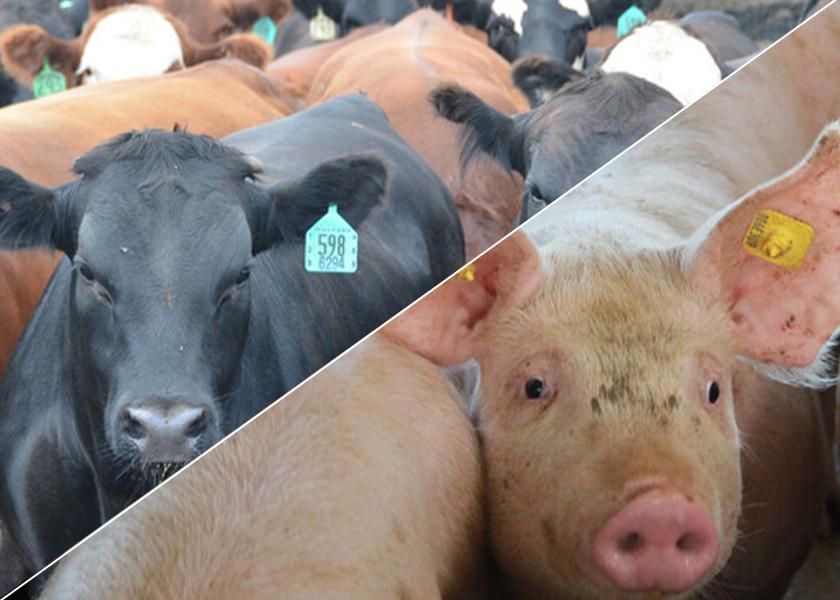Livestock Analysis | July 8, 2022

Price action: July lean hog futures fell 40 cents to $112.85. August hogs fell 32.5 cents to $109.175, still up a sharp $6.20 for the week.
5-day outlook: Hog futures posted a strong week as bullish technicals and easing concern over pork demand outweighed slippage in cash benchmarks. August futures briefly broke above a two-month trading range Thursday, hitting a nine-week intraday high at $11.75, which suggests the market may see followthrough technical buying early next week. The CME lean hog index rose 23 cents to $110.16 (as of July 5), the first gain in six days. August futures have dropped to a discount of 98.5 cents to the index after briefly posting a small premium earlier this week. Wholesale strength this week suggested demand is solid as retailers stock up for mid-summer featuring at the meat counter. Pork cutout values today early today rose $2.02 to $114.21.
30-day outlook: The bacon, lettuce and tomato sandwich season typically leads to stronger consumer demand for the pork cut, which could help underpin futures and cash. Hog slaughter levels should begin increasing from annual lows around mid-July, but the relative supply tightness should continue to support the cash and futures markets.
90-day outlook: The U.S. dollar’s rally to 20-year highs this week may be a bearish harbinger for the U.S. livestock industry, raising concern demand for dollar-denominated commodities could suffer. USDA today reported net weekly U.S. pork export sales totaling 31,200 MT, down 3% from the previous week but up 23% from the four-week average. U.S. pork exports will need to continue to show improvement in the coming months to keep a floor under cash and futures markets. The fall supply surge will almost surely pull cash prices downward, but whether those losses exceed the discounts already built into deferred futures is always a question at this time of year.
What to do: Be prepared to extend feed coverage when market bottoms are in place.
Hedgers: Carry all risk in the cash market for now.
Feed needs: You are hand-to-mouth on corn-for-feed and soybean meal needs.
Price action: August live cattle fell 60 cents to $133.95, down 65 cents for the week. August feeder futures slid 75 cents to $171.725, down $1.875 for the week.
5-day outlook: Live cattle futures ended the week on a soft note amid signs mid-week strength in cash was fading, with the Kansas market dropping about $2.00 from the heat-boosted prices reached in previous weeks. The five-area average for Tuesday-Thursday fell to $144.40, down $1.70 from the comparable week-ago figure. This is surprising given the obvious strength exhibited by wholesale beef prices this week. Choice cutout values early today slipped 7 cents to $268.14 but appears poised to end firmly up from $263.82 a week ago. Cash and wholesale markets appear to be holding together well early this summer, and we tend to expect more of the same. This should provide continued support for nearby cattle and feeder futures, although further seasonal slippage may occur.
30-day outlook: History strongly suggest the midsummer combination of seasonally weak consumer beef demand and some of the largest slaughter rates of the year will weigh upon cattle and beef prices through much of July and August. However, feedlot marketings are extremely current, as indicated by the midday Friday quote for the choice-select beef spread, which surged to $26.79. When combined with the apparent strength of consumer demand over the holiday weekend, this suggests the cattle/beef complex will not decline all that substantially in the short run. We don’t doubt that cash cattle prices will flounder during the coming weeks, but we think the decline will prove modest.
90-day outlook: After they managed to reduce front-end cattle supplies during spring, we see little reason to think producers will allow those supplies to build during the weeks and months ahead, especially since those numbers tend to decline seasonally through fall and winter. Beef demand does tend to shift away from steaks and toward roasts as the weather cools, but the general improvement in beef demand and the reduced supply will likely power a seasonal rally starting in late summer or early fall. The big question is how far the seasonal advance might carry the market. We had been concerned the large premiums in deferred contracts would prove to be self-defeating prophecies, but recent developments signal improved price prospects for the fall-winter-spring period.
What to do: Be prepared to extend feed coverage when market bottoms are in place.
Hedgers: Carry all risk in the cash market for now.
Feed needs: You are hand-to-mouth on corn-for-feed and soybean meal needs.






